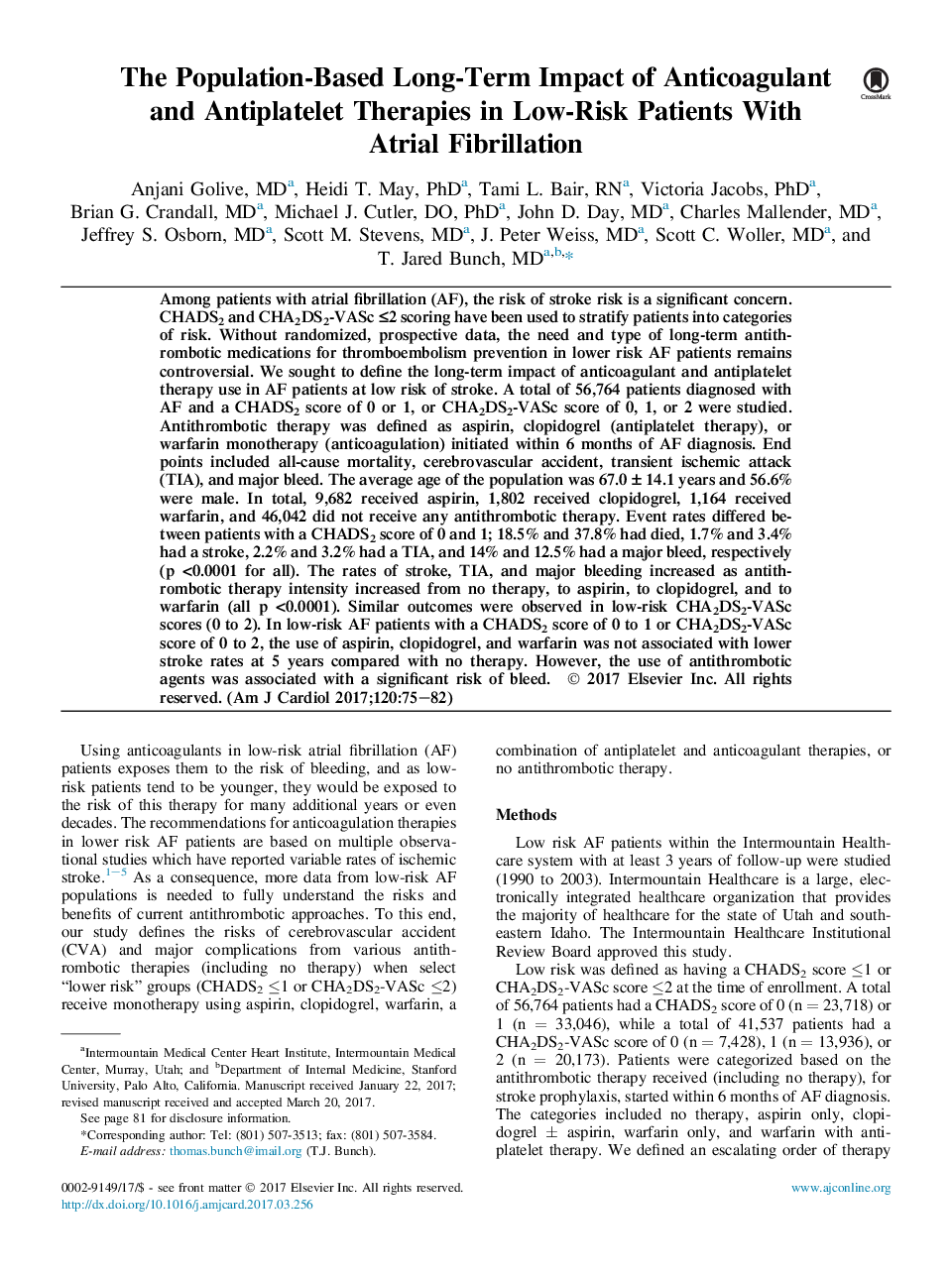| کد مقاله | کد نشریه | سال انتشار | مقاله انگلیسی | نسخه تمام متن |
|---|---|---|---|---|
| 5595571 | 1572083 | 2017 | 8 صفحه PDF | دانلود رایگان |
عنوان انگلیسی مقاله ISI
The Population-Based Long-Term Impact of Anticoagulant and Antiplatelet Therapies in Low-Risk Patients With Atrial Fibrillation
ترجمه فارسی عنوان
تاثیر طولانی مدت داروهای ضد انعقاد و آنتی بادی در بیماران کم خطر با فیبریلاسیون دهلیزی بر اساس جمعیت
دانلود مقاله + سفارش ترجمه
دانلود مقاله ISI انگلیسی
رایگان برای ایرانیان
موضوعات مرتبط
علوم پزشکی و سلامت
پزشکی و دندانپزشکی
کاردیولوژی و پزشکی قلب و عروق
چکیده انگلیسی
Among patients with atrial fibrillation (AF), the risk of stroke risk is a significant concern. CHADS2 and CHA2DS2-VASc â¤2 scoring have been used to stratify patients into categories of risk. Without randomized, prospective data, the need and type of long-term antithrombotic medications for thromboembolism prevention in lower risk AF patients remains controversial. We sought to define the long-term impact of anticoagulant and antiplatelet therapy use in AF patients at low risk of stroke. A total of 56,764 patients diagnosed with AF and a CHADS2 score of 0 or 1, or CHA2DS2-VASc score of 0, 1, or 2 were studied. Antithrombotic therapy was defined as aspirin, clopidogrel (antiplatelet therapy), or warfarin monotherapy (anticoagulation) initiated within 6 months of AF diagnosis. End points included all-cause mortality, cerebrovascular accident, transient ischemic attack (TIA), and major bleed. The average age of the population was 67.0 ± 14.1 years and 56.6% were male. In total, 9,682 received aspirin, 1,802 received clopidogrel, 1,164 received warfarin, and 46,042 did not receive any antithrombotic therapy. Event rates differed between patients with a CHADS2 score of 0 and 1; 18.5% and 37.8% had died, 1.7% and 3.4% had a stroke, 2.2% and 3.2% had a TIA, and 14% and 12.5% had a major bleed, respectively (p <0.0001 for all). The rates of stroke, TIA, and major bleeding increased as antithrombotic therapy intensity increased from no therapy, to aspirin, to clopidogrel, and to warfarin (all p <0.0001). Similar outcomes were observed in low-risk CHA2DS2-VASc scores (0 to 2). In low-risk AF patients with a CHADS2 score of 0 to 1 or CHA2DS2-VASc score of 0 to 2, the use of aspirin, clopidogrel, and warfarin was not associated with lower stroke rates at 5 years compared with no therapy. However, the use of antithrombotic agents was associated with a significant risk of bleed.
ناشر
Database: Elsevier - ScienceDirect (ساینس دایرکت)
Journal: The American Journal of Cardiology - Volume 120, Issue 1, 1 July 2017, Pages 75-82
Journal: The American Journal of Cardiology - Volume 120, Issue 1, 1 July 2017, Pages 75-82
نویسندگان
Anjani MD, Heidi T. PhD, Tami L. RN, Victoria PhD, Brian G. MD, Michael J. DO, PhD, John D. MD, Charles MD, Jeffrey S. MD, Scott M. MD, J. Peter MD, Scott C. MD, T. Jared MD,
